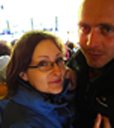




Bogota:
Bogota (2640m) is the capital city of Colombia and with around 7million of inhabitants is the 4th largest city in South America (after Sao Paulo, Buenos Aires and Rio de Janeiro). Bogota was originally called "Bacata" during the Muiscas civilization. The Spanish settlement was founded in 1538 by De Quesada and later "Bacata" became Bogota. In 1819 and following the victory of Simon Bolivar, Bogota became the capital of Gran Colombia, a federation combining the territories of modern Panama, Colombia, Venezuela, and Ecuador then after the break-up, the capital of Colombia.
We arrived in Bogota late evening and our stay started badly as the hostel we booked online did not have the required room and the next night, the booked room was given to somebody else! We left this hostel (called "Fatima Hostel") just to move to the corner of the street to a more friendly hostel, "Hostel Sue". And lucky as we were, it was raining every day, or during the morning, or during the afternoon or both! So our visits of the city and surroundings were limited by the "b.....y" weather!! We went to visit the town centre and the Candelaria district, Montserrate church using the Teleferico, the salt cathedral situated in the little town of Zipaquira and we went up to the Mirador of Colpatria Tower for superb panoramic views of Bogota. Travelling in this big city was easy using the Transmilenio, a bus sytem which covers the main streets and avenues. One of the places where it was difficult to walk was close to the Presidential Palace. We tried to take some pictures of a beautiful colonial building and for that we were standing on the pathway, ~2m from the walls of the Palace Gardens. The military guy asked us gently to move because we were getting to close (and obviously no picture of the Government Palace!)!!! Never in Bogota we were feeling unsafe and obviously our night walks were limited.
- Plaza de Bolivar, the main plaza of Bogota. In the picture, on the left (southern side), the "Capitolio Nacional" or "National Capitol" or Senate and on the right the "Edificio Lievano" a French-style building, dating from the early 20th century, seat of the Mayor Office. On the far left, the Statue of Simon Bolivar (sculpted in 1846),
- The Primary Cathedral (eastern side of Plaza Bolivar) was built between 1807 and 1823. On its right the Holy Chapel was built at the end of the 17th century,
- Santuario Nacional Nuestra Señora del Carmen built by the Italian-Colombian architect Buscaglione betwen 1926 and 1938. This Florentine-style cathedral is the Masterpiece of this architect,
- A totally different cathedral: the Salt Cathedral situated in the town of Zipaquira, North of Bogota. This Salt Cathedral is an underground church built inside a salt deposit in a tunnel made as result of the exploitation of the salinas (salt mines). Unfortunately, it was difficult to obtain good pictures due to low light inside the tunnel. In this picture, the walls are made in salt and the green colour is coming from an artificial light,
- This picture representing a nativity scene was taken by Lee. He managed to get better pictures than me but he was also struggling to get something decent!


No comments:
Post a Comment